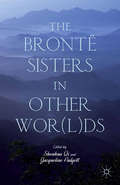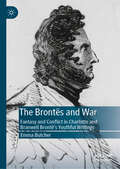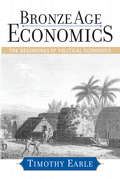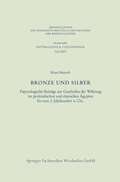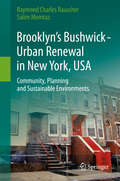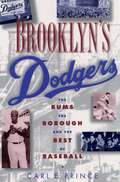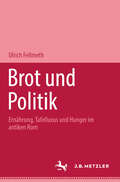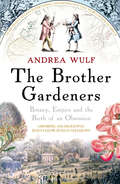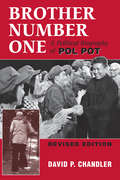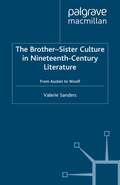- Table View
- List View
Bromance: Male Friendship, Love and Sport
by Stefan Robinson Eric AndersonUnraveling the stereotype that men’s friendships are unemotional and shallow, this book provides the first detailed account of the bromance that exists among young men. Drawing on one year of ethnography and 20 in-depth interviews among a university sport team, the authors show that these men reject traditional masculine boundaries, instead prioritizing an emotional and tactile form of friendship. Chapters detail the cultural shift in society’s views on bromances, showing that bromances exists as an elevated, more emotional and intimate form of friendship, existing as a further positive consequence of decreasing cultural homophobia. By focusing on sport—which has traditionally been seen as a homophobic environment with toxic constructions of manhood—the authors show that even in the most traditionally masculine of settings, young men are rethinking what male friendship looks like, what it means to be a man, and the positive impact this can have on their mental health. This book will be relevant to a number of audiences including scholars and students in masculinity studies, queer studies, and friendship studies; LGBTQ+ activists and allies with interest in straight men’s friendships and sports cultures; and men’s mental health advocates.
Bronisław Malinowski and His Legacy in Contemporary Social Sciences and Humanities: On the Centenary of Argonauts of the Western Pacific (ISSN)
by Grażyna KubicaAs one of the most renowned figures in the history of anthropology, Bronisław Malinowski is recognised as having been central to the development of the discipline, with interpretations of his thought usually drawing attention to his work in founding the approach of functionalism and his innovative method of intensive field research. This book offers a decisive extension of Malinowski’s achievement, referring to the accomplishments of present‑day social sciences and humanities and the debts that they owe to Malinowksi’s oeuvre.Bringing together eminent scholars in such fields as social anthropology, sociology, law, cultural studies, literary and theatre studies, and art history, this book emphasises the importance of Malinowski’s theoretical and methodological insights as a treasure trove of inspiration for contemporary researchers.A critical commentary on the life, work, and legacy of Bronisłw Malinowski, it sheds light on his academic work, while personal documents, many of which are not well known – or are completely unknown – in the Anglophone sphere, prove their fundamental importance for understanding his oeuvre, and the intellectual connections between his work and the work of other most prominent intellectuals of the 20th and 21st centuries. It will therefore appeal to scholars across the social sciences and humanities with interests in the history of anthropology and sociology and fundamental questions of theory and research methodology.
Bronisław Malinowski and His Legacy in Contemporary Social Sciences and Humanities: On the Centenary of Argonauts of the Western Pacific (ISSN)
As one of the most renowned figures in the history of anthropology, Bronisław Malinowski is recognised as having been central to the development of the discipline, with interpretations of his thought usually drawing attention to his work in founding the approach of functionalism and his innovative method of intensive field research. This book offers a decisive extension of Malinowski’s achievement, referring to the accomplishments of present‑day social sciences and humanities and the debts that they owe to Malinowksi’s oeuvre.Bringing together eminent scholars in such fields as social anthropology, sociology, law, cultural studies, literary and theatre studies, and art history, this book emphasises the importance of Malinowski’s theoretical and methodological insights as a treasure trove of inspiration for contemporary researchers.A critical commentary on the life, work, and legacy of Bronisłw Malinowski, it sheds light on his academic work, while personal documents, many of which are not well known – or are completely unknown – in the Anglophone sphere, prove their fundamental importance for understanding his oeuvre, and the intellectual connections between his work and the work of other most prominent intellectuals of the 20th and 21st centuries. It will therefore appeal to scholars across the social sciences and humanities with interests in the history of anthropology and sociology and fundamental questions of theory and research methodology.
Bronislaw Malinowski's Concept of Law
by Mateusz StępieńThis book discusses the legal thought of Bronislaw Malinowski (1884-1942), undoubtedly one of the titans of social sciences who greatly influenced not only the shape of modern cultural anthropology but also the social sciences as a whole. This is the first comprehensive work to focus on his legal conceptions: while much has been written about his views on language, magic, religion, and culture, his views on law have not been fairly reconstructed or recapitulated. A glance at the existing literature illustrates how little has been written about Malinowski’s understanding of law, especially in the legal sciences. This becomes even more evident given the fact that Malinowski devoted much of his scholarly work to studying law, especially in the last period of his life, during which he conducted broad research on law and “primitive jurisprudence”. The main aim of this book is to address this gap and to present in detail Malinowski’s thoughts on law. The book is divided into two parts. Part I focuses largely on the impact that works of two distinguished professors from his alma mater (L. Dargun and S. Estreicher) had on Malinowski’s legal thoughts, while Part II reconstructs Malinowski’s inclusive, broad and multidimensional understanding of law and provides new readings of his legal conceptions mainly from the perspective of reciprocity. The book offers a fresh look at his views on law, paving the way for further studies on legal issues inspired by his methodological and theoretical achievements. Malinowski’s understanding of law provides a wealth of fodder from which to formulate interesting research questions and a solid foundation for developing theories that more accurately describe and explain how law functions, based on new findings in the social and natural sciences.
The Bronte Myth
by Lucasta MillerSince 1857, hardly a year has gone by without some sort of Brontë 'biography' appearing. These range from pious accounts in Victorian conduct books to Freudian pyschobiographies, from plays, films and ballets to tourist brochures and images on tea-towels, from sensation-seeking penny-a-liners to meticulous works of sober scholarship. Each generation has rewritten the Brontës to reflect changing attitudes - towards the role of the woman writer, towards sexuality, towards the very concept of personality. The Brontë Myth gives vigorous new life to our understanding of the novelists and their culture and Lucasta Miller reveals as much about the impossible art of biography as she does about the Brontës themselves.
The Brontë Sisters in Other Wor(l)ds
by Shouhua Qi Jacqueline PadgettLooking at the works of the Brontë sisters through a translingual, transnational, and transcultural lens, this collection is the first book-length study of the Brontës as received and reimagined in languages and cultures outside of Europe and the United States.
The Brontës and War: Fantasy and Conflict in Charlotte and Branwell Brontë’s Youthful Writings
by Emma ButcherThis book explores the representations of militarisim and masculinity in Charlotte and Branwell Brontë’s youthful writings. It offers insight into how the siblings understood and reimagined conflict (both local and overseas) and its emotional legacies whilst growing up in early-nineteenth-century Britain. Their writings shed new light on a period little discussed by social and military historians, providing not only a new approach to Brontë Studies, but also acting as a familial case study for how the media captivated and enticed the public imagination.
Bronze Age Economics: The First Political Economies
by Timothy EarleThis integrated collection of new and newly revised essays by archaeologist Timothy Earle represents both a personal journey and a growing synthesis of how political economies emerged in human societies. Drawing in detail on the cases of chiefdoms in Hawaii, the Andes, and Denmark, Bronze Age Economics documents how intensification of economies, surplus mobilization, and controlled distribution of both staple and prestige goods fundamentally drove the political evolutionary processes that prefigured states. Representing as it does the trajectory of Earle's lifework, this book fairly encapsulates the history of processual archaeology and social evolutionary theory over the past quarter century.
Bronze Age Economics: The First Political Economies
by Timothy Earle"Timothy Earle has set out to offer the most comprehensive view now available of the economic foundations of early societies, and it may well be that he has succeeded. Bronze Age Economics is a pioneering contribution to archaeological theory." —Colin Renfrew, University of Cambridge
Bronze Age Worlds: A Social Prehistory of Britain and Ireland
by Robert JohnstonBronze Age Worlds brings a new way of thinking about kinship to the task of explaining the formation of social life in Bronze Age Britain and Ireland. Britain and Ireland’s diverse landscapes and societies experienced varied and profound transformations during the twenty-fifth to eighth centuries BC. People’s lives were shaped by migrations, changing beliefs about death, making and thinking with metals, and living in houses and field systems. This book offers accounts of how these processes emerged from social life, from events, places and landscapes, informed by a novel theory of kinship. Kinship was a rich and inventive sphere of culture that incorporated biological relations but was not determined by them. Kinship formed personhood and collective belonging, and associated people with nonhuman beings, things and places. The differences in kinship and kinwork across Ireland and Britain brought textures to social life and the formation of Bronze Age worlds. Bronze Age Worlds offers new perspectives to archaeologists and anthropologists interested in the place of kinship in Bronze Age societies and cultural development.
Bronze Age Worlds: A Social Prehistory of Britain and Ireland
by Robert JohnstonBronze Age Worlds brings a new way of thinking about kinship to the task of explaining the formation of social life in Bronze Age Britain and Ireland. Britain and Ireland’s diverse landscapes and societies experienced varied and profound transformations during the twenty-fifth to eighth centuries BC. People’s lives were shaped by migrations, changing beliefs about death, making and thinking with metals, and living in houses and field systems. This book offers accounts of how these processes emerged from social life, from events, places and landscapes, informed by a novel theory of kinship. Kinship was a rich and inventive sphere of culture that incorporated biological relations but was not determined by them. Kinship formed personhood and collective belonging, and associated people with nonhuman beings, things and places. The differences in kinship and kinwork across Ireland and Britain brought textures to social life and the formation of Bronze Age worlds. Bronze Age Worlds offers new perspectives to archaeologists and anthropologists interested in the place of kinship in Bronze Age societies and cultural development.
Bronze und Silber: Papyrologische Beiträge zur Geschichte der Währung im ptolemäischen und römischen Ägypten bis zum 2. Jahrhundert n. Chr. (Abhandlungen der Nordrhein-Westfälischen Akademie der Wissenschaften #25)
by Klaus MareschBronze-Working Centres Of Western Asia
by John CurtisFirst published in 1988, the present volume contains the texts of papers read at a three-day Colloquium on bronzeworking centres in Western Asia from 1000 BC until the beginning of the Achaemenian period in 539 BC, which was held in the British Museum in July 1986. Each paper has been revised in the light of the discussion which followed it. The Colloquium was organized by Dr J E Curtis on behalf of the Department of Western Asiatic Antiquities and forms the first in a series which it is hoped will be held annually.
Bronze-Working Centres Of Western Asia
by John CurtisFirst published in 1988, the present volume contains the texts of papers read at a three-day Colloquium on bronzeworking centres in Western Asia from 1000 BC until the beginning of the Achaemenian period in 539 BC, which was held in the British Museum in July 1986. Each paper has been revised in the light of the discussion which followed it. The Colloquium was organized by Dr J E Curtis on behalf of the Department of Western Asiatic Antiquities and forms the first in a series which it is hoped will be held annually.
The Brooklyn Thrill-Kill Gang and the Great Comic Book Scare of the 1950s
by Mariah AdinWhat caused four recently bar mitzvahed middle-class youths to go on a crime spree of assault and murder in 1954? This book provides a compelling narrative retelling of the boys, their crimes, and a U.S. culture obsessed with juvenile delinquency.After ongoing months of daily headlines about gang shootouts, stomp-killings, and millions of dollars worth of vandalism, by the summer of 1954, America had had enough of juvenile delinquency. It was in this environment that 18-year-old Jack Koslow and the other three teenage members of the Brooklyn Thrill Killers committed their heinous crimes and achieved notoriety. The Brooklyn Thrill-Kill Gang and the Great Comic Book Scare of the 1950s exposes the underbelly of America's mid-century, the terrible price of assimilation, the uncomfortable bedfellows of comic books and juvenile delinquency, and the dystopia already in bloom amongst American youth well before the 1960s. Readers will be engrossed and horrified by the tale of the Brooklyn Thrill-Kill Gang whose shocking, front-page story could easily have been copy-pasted from today's online news sites. Author Mariah Adin takes readers along for a breathtaking moment-by-moment retelling of the crime spree, the subsequent interrogations, and the dramatic courtroom showdown, interspersed with expository chapters on juvenile delinquency, America's Jewish community in the post-Holocaust period, and the anti-comics movement. This book serves to merge the history of juvenile delinquency with that of the Great Comic Book Scare, highlights the assimilation of immigrants into America's white mainstream gone wrong, and complicates our understanding of America's "Golden Age."
The Brooklyn Thrill-Kill Gang and the Great Comic Book Scare of the 1950s
by Mariah AdinWhat caused four recently bar mitzvahed middle-class youths to go on a crime spree of assault and murder in 1954? This book provides a compelling narrative retelling of the boys, their crimes, and a U.S. culture obsessed with juvenile delinquency.After ongoing months of daily headlines about gang shootouts, stomp-killings, and millions of dollars worth of vandalism, by the summer of 1954, America had had enough of juvenile delinquency. It was in this environment that 18-year-old Jack Koslow and the other three teenage members of the Brooklyn Thrill Killers committed their heinous crimes and achieved notoriety. The Brooklyn Thrill-Kill Gang and the Great Comic Book Scare of the 1950s exposes the underbelly of America's mid-century, the terrible price of assimilation, the uncomfortable bedfellows of comic books and juvenile delinquency, and the dystopia already in bloom amongst American youth well before the 1960s. Readers will be engrossed and horrified by the tale of the Brooklyn Thrill-Kill Gang whose shocking, front-page story could easily have been copy-pasted from today's online news sites. Author Mariah Adin takes readers along for a breathtaking moment-by-moment retelling of the crime spree, the subsequent interrogations, and the dramatic courtroom showdown, interspersed with expository chapters on juvenile delinquency, America's Jewish community in the post-Holocaust period, and the anti-comics movement. This book serves to merge the history of juvenile delinquency with that of the Great Comic Book Scare, highlights the assimilation of immigrants into America's white mainstream gone wrong, and complicates our understanding of America's "Golden Age."
Brooklyn’s Bushwick - Urban Renewal in New York, USA: Community, Planning and Sustainable Environments
by Raymond Charles Rauscher Salim MomtazThis book offers an extended case study of the urban community of Bushwick, located in the Brooklyn borough of New York City. The authors begin with a broad review of the history of Bushwick and Brooklyn, from before the earliest European settlements of the 1600s, through the 18th and 19th centuries and up the 1960s. Chapter Two begins by tracing the steep decline of the community, which culminated in catastrophic fires and looting in the wake of New York’s electrical blackout of 1977 and goes on to describe the beginnings of urban planning and renewal efforts which launched the recovery of Bushwick in the 1980s to early 2000s. Chapter Three steps back from the immediacy of the community to discuss urban change from a theoretical perspective. The authors outline advances in ‘sustainable urban planning’ and describe how these apply to Bushwick and the wider Brooklyn community.Chapter Four offers a detailed examination of the intent and function of New York’s community board planning system, known as the Charter 197-a program. In Chapter Five the authors examine the 197-a planning process and its application in the areas of Bushwick, Williamsburg and Greenpoint in Northeast Brooklyn; Brooklyn Downtown and in Southeast Brooklyn including Coney Island. The following chapter examines a number of innovative Bushwick high schools that offer practical experience in urban planning. Drawing the urban planning experiences together, the book concludes with a look at future directions in city renewal. Emphasis here is placed on ‘sustainable urban planning’ and the lessons to be learned from the experience of Bushwick and Brooklyn.The specifics of urban planning and renewal are illustrated with tables and figures. The details of planning are informed by an overarching sense of history, beginning with the dedication of the book to the memory of six Universalist writers associated with New York: Henry Thoreau, Helena Blavatsky, Henry George, Henry Miller, Arthur Miller and Walt Whitman. A rich trove of historical materials, ranging from family sketches to school rosters to rarely seen photographs, helps to keep the survey and analysis of urban planning grounded in the lives of Bushwick’s residents, past, present and future.
Brooklyn's Dodgers: The Bums, the Borough, and the Best of Baseball, 1947-1957
by Carl E. PrinceDuring the 1952 World Series, a Yankee fan trying to watch the game in a Brooklyn bar was told, "Why don't you go back where you belong, Yankee lover?" "I got a right to cheer my team," the intruder responded, "this is a free country." "This ain't no free country, chum," countered the Dodger fan, "this is Brooklyn." Brooklynites loved their "Bums"--Pee Wee Reese, Jackie Robinson, Duke Snider, Roy Campanella, and all the murderous parade of regulars who, after years of struggle, finally won the World Series in 1955. One could not live in Brooklyn and not catch its spirit of devotion to its baseball club. In Brooklyn's Dodgers, Carl E. Prince captures the intensity and depth of the team's relationship to the community and its people in the 1950s. Ethnic and racial tensions were part and parcel of a working class borough; the Dodgers' presence smoothed the rough edges of the ghetto conflict always present in the life of Brooklyn. The Dodger-inspired baseball program at the fabled Parade Grounds provided a path for boys that occasionally led to the prestigious "Dodger Rookie Team," and sometimes, via minor league contracts, to Ebbets Field itself. There were the boys who lined Bedford Avenue on game days hoping to retrieve home run balls and the men in the many bars who were not only devoted fans but collectively the keepers of the Dodger past--as were Brooklyn women, and in numbers. Indeed, women were tied to the Dodgers no less than their husbands, fathers, brothers, and sons; they were only less visible. A few, like Pulitzer Prize-winning poet Marianne Moore and working class stiff Hilda Chester were regulars at Ebbets Field and far from invisible. Prince also explores the underside of the Dodgers--the "baseball Annies," and the paternity suits that went with the territory. The Dodgers' male culture was played out as well in the team's politics, in the owners' manipulation of Dodger male egos, opponents' race-baiting, and the macho bravado of the team (how Jackie Robinson, for instance, would prod Giants' catcher Sal Yvars to impotent rage by signaling him when he was going to steal second base, then taunting him from second after the steal). The day in 1957 when Walter O'Malley, the owner of the Brooklyn Dodgers, announced that the team would be leaving for Los Angeles was one of the worst moments in baseball history, and a sad day in Brooklyn's history as well. The Dodger team was, to a degree unmatched in other major league cities, deeply enmeshed in the life and psyche of Brooklyn and its people. In this superb volume, Carl Prince illuminates this "Brooklyn" in the golden years after the Second World War.
Brooklyn's Dodgers: The Bums, the Borough, and the Best of Baseball, 1947-1957
by Carl E. PrinceDuring the 1952 World Series, a Yankee fan trying to watch the game in a Brooklyn bar was told, "Why don't you go back where you belong, Yankee lover?" "I got a right to cheer my team," the intruder responded, "this is a free country." "This ain't no free country, chum," countered the Dodger fan, "this is Brooklyn." Brooklynites loved their "Bums"--Pee Wee Reese, Jackie Robinson, Duke Snider, Roy Campanella, and all the murderous parade of regulars who, after years of struggle, finally won the World Series in 1955. One could not live in Brooklyn and not catch its spirit of devotion to its baseball club. In Brooklyn's Dodgers, Carl E. Prince captures the intensity and depth of the team's relationship to the community and its people in the 1950s. Ethnic and racial tensions were part and parcel of a working class borough; the Dodgers' presence smoothed the rough edges of the ghetto conflict always present in the life of Brooklyn. The Dodger-inspired baseball program at the fabled Parade Grounds provided a path for boys that occasionally led to the prestigious "Dodger Rookie Team," and sometimes, via minor league contracts, to Ebbets Field itself. There were the boys who lined Bedford Avenue on game days hoping to retrieve home run balls and the men in the many bars who were not only devoted fans but collectively the keepers of the Dodger past--as were Brooklyn women, and in numbers. Indeed, women were tied to the Dodgers no less than their husbands, fathers, brothers, and sons; they were only less visible. A few, like Pulitzer Prize-winning poet Marianne Moore and working class stiff Hilda Chester were regulars at Ebbets Field and far from invisible. Prince also explores the underside of the Dodgers--the "baseball Annies," and the paternity suits that went with the territory. The Dodgers' male culture was played out as well in the team's politics, in the owners' manipulation of Dodger male egos, opponents' race-baiting, and the macho bravado of the team (how Jackie Robinson, for instance, would prod Giants' catcher Sal Yvars to impotent rage by signaling him when he was going to steal second base, then taunting him from second after the steal). The day in 1957 when Walter O'Malley, the owner of the Brooklyn Dodgers, announced that the team would be leaving for Los Angeles was one of the worst moments in baseball history, and a sad day in Brooklyn's history as well. The Dodger team was, to a degree unmatched in other major league cities, deeply enmeshed in the life and psyche of Brooklyn and its people. In this superb volume, Carl Prince illuminates this "Brooklyn" in the golden years after the Second World War.
Brooklyn’s Renaissance: Commerce, Culture, and Community in the Nineteenth-Century Atlantic World
by Melissa Meriam BullardThis book shows how modern Brooklyn’s proud urban identity as an arts-friendly community originated in the mid nineteenth century. Before and after the Civil War, Brooklyn’s elite, many engaged in Atlantic trade, established more than a dozen cultural societies, including the Philharmonic Society, Academy of Music, and Art Association. The associative ethos behind Brooklyn’s fine arts flowering built upon commercial networks that joined commerce, culture, and community. This innovative, carefully researched and documented history employs the concept of parallel Renaissances. It shows influences from Renaissance Italy and Liverpool, then connected to New York through regular packet service like the Black Ball Line that ferried people, ideas, and cargo across the Atlantic. Civil War disrupted Brooklyn’s Renaissance. The city directed energies towards war relief efforts and the women’s Sanitary Fair. The Gilded Age saw Brooklyn’s Renaissance energies diluted by financial and political corruption, planning the Brooklyn Bridge and consolidation with New York City in 1898.
Brooklyn’s Renaissance: Commerce, Culture, and Community in the Nineteenth-Century Atlantic World
by Melissa Meriam BullardThis book shows how modern Brooklyn’s proud urban identity as an arts-friendly community originated in the mid nineteenth century. Before and after the Civil War, Brooklyn’s elite, many engaged in Atlantic trade, established more than a dozen cultural societies, including the Philharmonic Society, Academy of Music, and Art Association. The associative ethos behind Brooklyn’s fine arts flowering built upon commercial networks that joined commerce, culture, and community. This innovative, carefully researched and documented history employs the concept of parallel Renaissances. It shows influences from Renaissance Italy and Liverpool, then connected to New York through regular packet service like the Black Ball Line that ferried people, ideas, and cargo across the Atlantic. Civil War disrupted Brooklyn’s Renaissance. The city directed energies towards war relief efforts and the women’s Sanitary Fair. The Gilded Age saw Brooklyn’s Renaissance energies diluted by financial and political corruption, planning the Brooklyn Bridge and consolidation with New York City in 1898.
Brot und Politik: Ernährung, Tafelluxus und Hunger im antiken Rom
by Ulrich FellmethWenn die Getreidelieferungen aus den Provinzen ausblieben, wurde es für 95 Prozent der Bevölkerung des antiken Rom eng; nur eine dünne Oberschicht konnte den sprichwörtlichen Tafelluxus der Römer zelebrieren. Die Ernährungsgewohnheiten, die Hungerkrisen mit ihren Ursachen und Konsequenzen und die Reaktionen der Politik sind Thema dieses Buches.
The Brother Gardeners: Botany, Empire and the Birth of an Obsession
by Andrea WulfOne January morning in 1734, cloth merchant Peter Collinson hurried down to the docks at London's Custom House to collect cargo just arrived from John Bartram in the American colonies. But it was not bales of cotton that awaited him, but plants and seeds...Over the next forty years, Bartram would send hundreds of American species to England, where Collinson was one of a handful of men who would foster a national obsession and change the gardens of Britain forever: Philip Miller, author of the bestselling Gardeners Dictionary; the Swede Carl Linnaeus, whose standardised botanical nomenclature popularised botany; the botanist-adventurer Joseph Banks and his colleague Daniel Solander who both explored the strange flora of Tahiti and Australia on Captain Cook's Endeavour.This is the story of these men - friends, rivals, enemies, united by a passion for plants. Set against the backdrop of the emerging empire and the uncharted world beyond, The Brother Gardeners tells the story how Britain became a nation of gardeners.
Brother Number One: A Political Biography Of Pol Pot
by David P Chandler"Excellent and absorbing.... Indispensable to any attempt to understand the Khmer Rouge." -William Shawcross New York Review of Books "A dramatic account of Pol Pot's rise to power in 1975 and his direction of Cambodia's autogenocide.... David Chandler has given us an absorbing and authoritative portrait of Brother Number One and a fascinating insight into Cambodia's cruel history." —Frederick Z. Brown New York Times Book Review "This first biography of Pol Pot is valuable not just for what it tells us about Cambodia's past, but for helping us understand the present and perhaps predict the future.... Superbly written, pioneering work. Chandler makes up for the paucity of details about Pol Pot's life by painting a rich tableau of his times and setting out the historical context of his policies.... The only plausible portrait of the man whose gentle persona and brutal actions remain an enduring paradox." -Nayan Chanda Far Eastern Economic Review "This book is particularly welcome. Although a work of scholarship, [it] has the fast pace of a thriller.... [Chandler's] analysis rings true, and he has no ideological axe to grind; he is willing to go where the evidence takes him." -Asian Wall Street Journal Weekly "Chandler's gracefully written biography of the enigmatic revolutionary of this century, Saloth Sar (alias Pol Pot), deserves wide readership.... Chandler successfully walks a fine line, condemning Pol Pot and all his works, but trying to understand what motivates him.... Recommended without reservation." -Choice "No biographer could hope for a more elusive or enigmatic subject than Pol Pot. From interviews and extensive research, Chandler pieces together a riveting account of the life of this inaccessible man who was alternately mild mannered, cultivated, and genocidal.... Highly recommended." -Library Journal In Cambodia's recent, tragic past, no figure looms larger or more ominously than that of Pol Pot. In this revised edition of the first book-length study of the man, the historian David P. Chandler throws light on the shadowy figure of Pol Pot, illuminating the ideas and behavior of this enigmatic man and his entourage against the background of post-World War II events, providing a key to understanding this horrific, pivotal period of Cambodian history.
The Brother-Sister Culture in Nineteenth-Century Literature: From Austen to Woolf
by V. SandersThis book argues that brother-sister relationships, idealized by the Romantics, intensified in nineteenth-century English domestic culture, and is a neglected key to understanding Victorian gender relations. Attracted by the apparent purity of the sibling bond, novelists and poets also acknowledged its innate ambivalence and instability, through conflicting patterns of sublimated devotion, revenge fantasy, and corrosive obsession. The final chapter shows how the brother-sister bond was permanently changed by the experience of the First World War.




